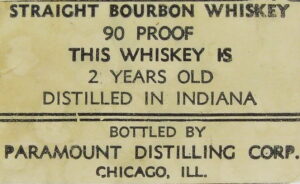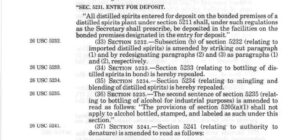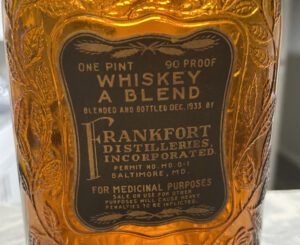interregnum /ˌɪntəˈrɛɡnəm/ noun
an interval or pause between two periods of office or other things.
As part of my job leading tours and tastings at Four Roses, I begin by providing an overview of the brand’s history with our guests. When discussing Prohibition (1920 to 1933) I explain that Four Roses (or more specifically, Frankfort Distilling Corporation) was one of the six distilleries able to continue to do business during those years selling existing stocks of spirits, bottled and packaged for ‘medicinal purposes’ using a federally issued permit. These spirits, whiskey in the case of Four Roses, could then be purchased legally by obtaining a prescription from a physician after being ‘diagnosed’ with one of a small set of qualifying illnesses [1]. Physicians who prescribed spirits for medicinal purposes, as well as the pharmacies which then fulfilled the prescriptions, all needed to have federally issued permits to do so. All of this was laid out in a document published by the federal government colloquially referred to as Regulations 60 [2].
When medicinal whiskey is described like this, guests (who often snicker at the notion) are given the impression that all of this was something of a dodge invented specifically as a response to Prohibition, a clever legal loophole. But this is of course is completely untrue. People were using spirits as medicine in the United States well before Prohibition and laws during Prohibition just allowed them to continue doing so. The practice came over with European settlers. It embedded itself quickly, along with the technique of distillation, into the foundations of their new country [3]. You might say the country was raised on it.
To give you an idea of how seriously whiskey was regarded as a medicine, it was included in several early American medical formularies (or dispensaries), collections of substances recognized as having legitimate medical value and that might be prescribed by a physician or pharmacist. More importantly, it appeared in the very first edition of the United States Pharmacopeia or U.S.P., published sometime around 1840. The intent of the U.S.P. was to provide a reference that would “put in place standards for the quality of medicines that would protect the public’s health” (source: usp.org). There could be no higher endorsement made for whiskey-as-medicine at the time.
Like it’s predecessor publications, the U.S.P. listed whiskey using the more formal and scientific-sounding name Spiritus Frumenti, Latin for ‘spirit of the grain’ [4]. It was defined as “an alcoholic liquid obtained by the distillation of the mash of fermented grain (usually of mixtures of corn, wheat, and rye), and at least 2 years old.” Today we’d just call this straight whiskey [5].
It was also common during the late 19th and early 20th centuries for whiskey brands to include medical endorsements as part of print advertising. These could include testaments regarding the purity of the product and/or its beneficial health effects. An ad for Green River Distilling Company in 1908 states that it’s not only “The Whiskey Without a Headache” but also the official whiskey of U.S. Navy hospitals. A 1915 ad for James E. Pepper made the astounding claim “Endorsed and Used in Practice by 40,000 Physicians” [6].
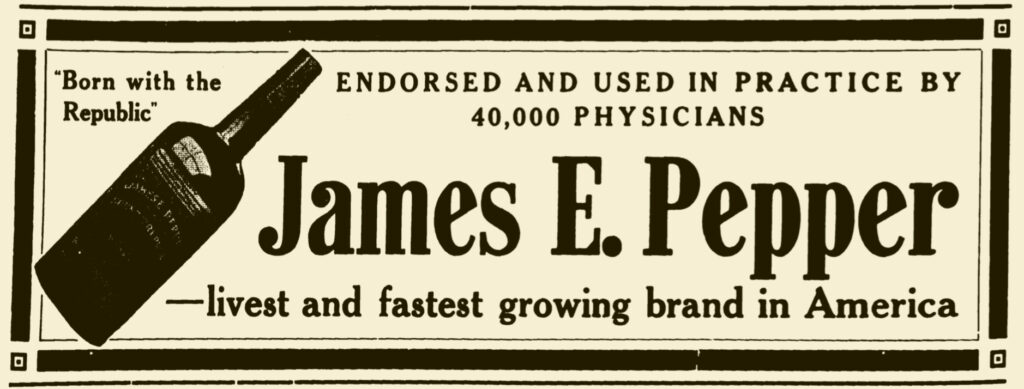
The slide towards the end
Spiritus Frumenti would remain listed in every edition of the U.S.P. until 1916, by which time opinions on the value of whiskey-as-medicine had started to shift. This was reflected in the vote taken by the committee of medical professionals responsible for revising what would become the 9th edition of the reference, just about to be published. The committee was divided on the matter and whiskey was removed with just the barest of a majority voting ‘no’. But context matters and by this time the country was on the cusp of national Prohibition, a mere four years away. Many states were already ‘dry’ by this point. So the decision probably reflected what might be thought of as a societal ‘tipping point’ toward Prohibition at the national level [7].
Being de-listed from the U.S.P. didn’t of course mean that people suddenly stopped believing that whiskey had any medicinal properties. It just meant whiskey could no longer be formally recommended as medicine by a physician. But this didn’t stop individuals from claiming they intended to use it as such. This had already become a popular means of getting around state-level prohibition.
As more states enacted prohibition laws (some as early as the 1890s) it became increasingly common to ship whiskey by rail from ‘wet’ to ‘dry’ states in order to circumvent them. Regardless of the buyers actual intent, if shipments were marked as being specifically for medicinal purposes, it was possible to avoid having shipments confiscated in transit [6]. This was somewhat practical for orders placed by individuals buying relatively small quantities of bottled product but, for obvious reasons, not viable for wholesalers buying by the barrel [8]. Either way, in 1913 the federal government shut the door on this loophole when it passed the Webb-Kenyon Act, upholding the rights of ‘dry’ states.
It should also be pointed out that in 1917, in response to WWI, the federal government passed the Lever Food and Fuel Control Act which forbid the production of alcohol for any food or beverage purpose. The idea was to conserve supplies of grain, among other agricultural products, deemed more important that it be used as foodstuffs or the war effort itself. This meant existing stocks of whiskey would already have been drawn down for two years by the time national Prohibition starts. Adding injury to insult: the act also imposed an additional excise tax on whiskey already held in bond.
Seen together, the removal of whiskey from the U.S.P. and the inability to ship whiskey from ‘wet’ to ‘dry’ states, along with the effects of the Lever Act, made it clear that the nation was poised to adopt Prohibition. All that remained was the ratification of the 18th amendment, which came in 1919, followed swiftly by passage of the National Prohibition Act, AKA The Volstead Act, which took effect on January 16, 1920.
And that’s when a rather odd thing happens: in the exact same moment as national Prohibition is given the force of law, whiskey gains official status as a medicine once again.
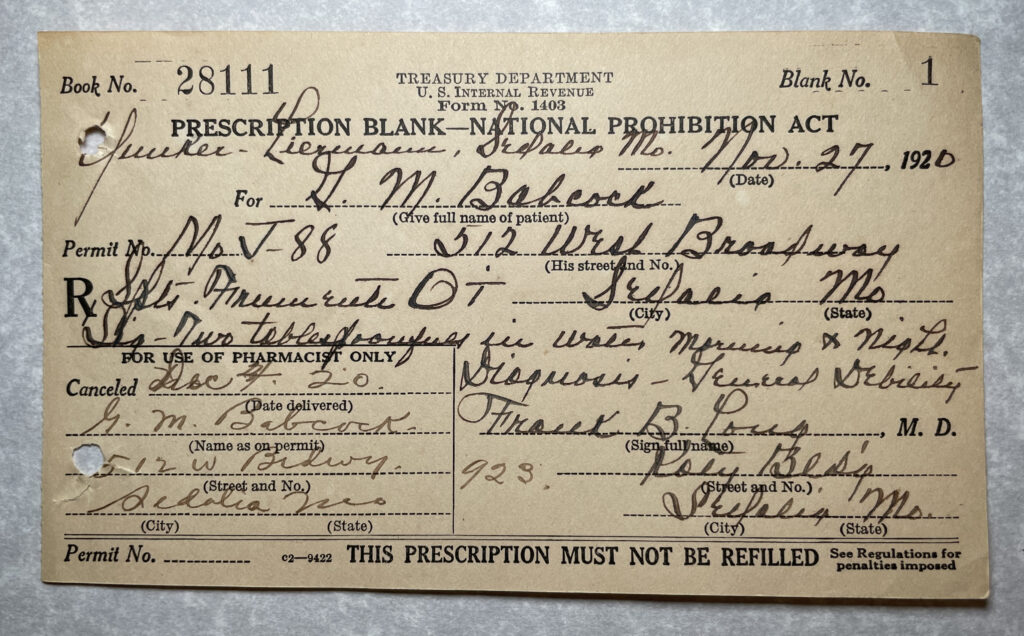
The brief final resurgence
Now to make things completely clear, this did not happen because whiskey had become magically re-listed in the U.S.P.. It happened simply because the federal government, who got to write the rules enacting Prohibition, makes it possible for whiskey to be obtained just as if it had been—only with a few new hoops to go through first, e.g. needing a doctor’s prescription, something that had never been required to buy it (regardless of purpose) before. The exact reasons for making it available like this are more than a little unclear. Here are two possibilities:
- Maybe it was the result of pressure applied to congress from that same group of physicians who had voted to keep whiskey listed in the U.S.P. back in 1916. These people still felt there were legitimate medical applications for it.
- Maybe it was adopted under pressure from distilleries that were sitting on (i.e. stuck with) large amounts of aging whiskey they’d otherwise be unable to sell and for which they’d probably still owe taxes when it was removed from bond.
Either or both of these groups might have been able to influence policies which had to have been drafted quickly in the final run up to national Prohibition [9]. Regardless of exact circumstances, in 1920 the federal government publishes their guidelines, the already mentioned Regulations 60, and whiskey becomes medicine once again, even if only for the duration of Prohibition [10].
Despite efforts by some members of the American Medical Association, reflected in a vote taken in 1922, whiskey would never again be considered a necessary medicine and so it was never to be re-listed in the U.S.P.. Those days were done, and after the repeal of Prohibition in 1933, so would the need for prescriptions to buy it. This would also be the last time whiskey would be referred to by its fancy Latin name Spiritus Frumenti. The brief interregnum was over.
In the post-Prohibition world, whiskey and medicine had been finally de-coupled, at least in the eyes of the federal government. Advertising for whiskey would never again include testimony by physicians regarding the purity of a particular brand nor its efficacy as medicine. Instead the consumption of whiskey would increasingly be linked with aspirational themes of wealth and leisure, but that’s another story.

Addenda
Try as I might, I could not locate any on-line versions of the U.S.P. published prior to the 9th edition when whiskey was still listed. Even searches at the National Library of Medicine turned up nothing. I did eventually find what appears to be a more complete definition for the physical characteristics of Spiritus Frumenti from a book called King’s American Dispensatory, Vol. II, by Felter and Lloyd (Nineteenth Edition, Third Revision, 1905, originally published in 1854). The attribution given is the U.S.P., but neither an edition nor a publication date is provided, so I feel it should be treated with a little suspicion. I’m including it here as an unverified curiosity for anyone interested in this level of detail.
“An amber-colored liquid, having a distinctive odor and taste, and a slightly acid reaction. Its specific gravity should not be more than 0.930, nor less than 0.917, corresponding, approximately, to an alcoholic strength of 44 to 50 per cent by weight, or 50 to 58 per cent by volume. If 100 Cc. of whiskey be very slowly evaporated in a tared capsule on a water-bath, the last portions volatilized should not have a harsh or disagreeable odor (absence of more than traces of fusel oil from grain); and the residue, when dried at 100° C. (212° F.), should not weigh more than 0.25 Gm. This residue should have no sweet or distinctly spicy taste (absence of added sugar, glycerin, or aromatic substances). It should almost completely dissolve in 10 Cc. of cold water, forming a solution which is colored not deeper than light green by a few drops of dilute ferric chloride T.S. made by mixing the latter with 10 volumes of water (absence of more than traces of oak tannin from casks). To render 100 Cc. of whiskey distinctly alkaline to litmus should not require more than 1.2 Cc. of potassium hydrate V.S. (limit of free acid). —(U.S.P.)”
A few days after publishing this article, I made a visit to the Oscar Getz Museum of Whiskey History in Bardstown where I spotted this amazing poster on the wall. It was printed in 1920 by the National Women’s Christian Temperance Union to celebrate the removal of whiskey and brandy from the U.S.P. in 1915. It’s very hard not to see the irony in the timing of this, right after national Prohibition made whiskey and brandy back into medicines once again, available only with a doctor’s prescription. There’s even a quote in the lower left corner which reads: “Doctors agree that alcohol should not be used as a medicine, except when prescribed by a competent physician. Very little is prescribed by any doctor compared with fifty years ago. Very many doctors never prescribe alcohol.”
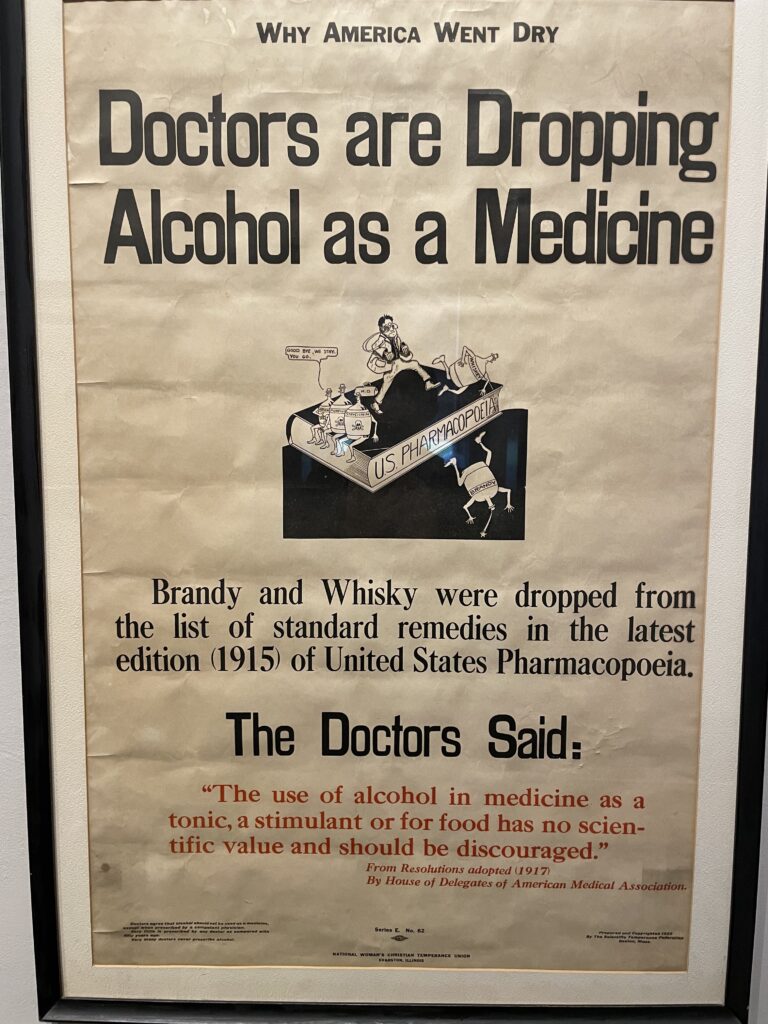
—
Notes:
[1] The list of typical ailments for which whiskey could be prescribed included: asthma, hypertension, diabetes, shock, cancer, insomnia, snake bites, certain types of poisoning. Mind you during prohibition it could be and was prescribed much more loosely. The diagnosis on many prescriptions read simply enough ‘general debility.’
[2] The full name of this 119-page document was Regulations 60 Relative to the Manufacture Sale, Barter, Transportation, Importation Exportation, Delivery, Furnishing, Purchase, Possession, And Use of Intoxicating Liquor Under Title II of the National Prohibition Act of October 28, 1919, Providing for the Enforcement of the Eighteenth Amendment to the Constitution of the United States. I am always impressed by the the Federal government’s apparent fetish for documents with long imposing titles. But what’s really impressive here is that the federal government had all of this ready to roll out as soon as the 18th amendment was given the force of law.
[3] The tradition of using alcoholic beverages as medicine grew up with civilization itself. Summarizing this history is well beyond the scope of this article, to say the least. Fortunately, an excellent account of spirits-as-medicine has just been recently published. The book Doctors and Distillers by Camper English (Penguin Books, 2022) provides a great introduction to this subject. Camper also graciously provided me with a few of the details I used to write this article.
[4] Medicinal brandy was also listed using a fancy Latin name: Spiritus Vini Gallici, literally ‘spirit of French wine.’ Not highly imaginative.
[5] It is interesting to note that this definition may provide a key to understanding the standard of ‘straight’ whiskey that was created after Prohibition, to wit: that a ‘straight whiskey’ in addition to being made entirely from fermented grain also needs to be a minimum of two years of age. No other pre-Prohibition discussion of ‘straight’ ever mentions a minimum age requirement. So maybe the U.S.P. was the source for that part of the modern standard? However, by the time the eighth edition of the U.S.P. is published, the minimum age had been increased to four years, which possibly undermines this theory.
[6] In an attempt to even further link a brand with medicine, in 1870 George Garvin Brown notoriously called his whiskey ‘Old Forrester,’ named after Louisville physician William Forrester. Early ads even included the phrase “The Doctors Choice.” Brown would later drop one of the ‘r’s from the name for reasons that were never made entirely clear by the company. But it’s easy to guess it was because Brown had never asked Forrester permission to use his name.
[7] The physicians on the committee who believed whiskey had legitimate medical applications attempted to keep it listed by advocating for additional wording that would explicitly exclude cheap rectified products, which they felt had eroded whiskey-as-medicine’s reputation. What’s odd about this is that the original U.S.P. definition had always already been quite clear that Spiritus Frumenti was made only from grain. What more could usefully be added? This might be seen as something of a ‘Hail Mary’ on the part of physicians who were against national Prohibition.
[8] The effects of prohibition at the state level on whiskey commerce is discussed extensively by Karl Raitz in the section about the Henry McKenna distillery in Making Bourbon.
[9] Start to finish, the ratification of the 18th amendment took slightly over two years. The federal government probably laid as much administrative groundwork as possible during this time, anticipating what had to be seen as an inevitable outcome.
[10] An unanswered question is what rights the states and counties which implemented prohibition before the 18th amendment (and Regulations 60) had regarding the sale of medicinal whiskey once it was made legal. Were they forced to comply with the new federal law or could they remain completely ‘dry’?

